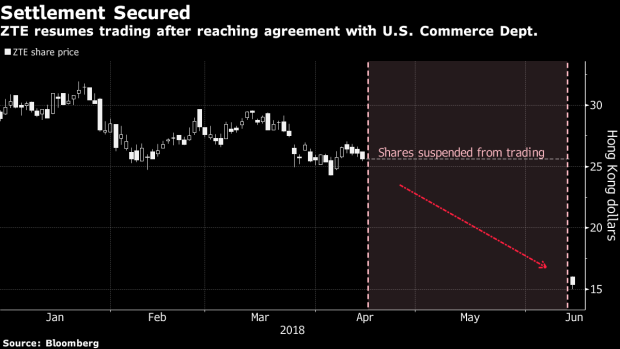Jun 13, 2018
ZTE's $2.7 Billion Loss Shows Tougher Challenges After U.S. Fine
, Bloomberg News

(Bloomberg) -- ZTE Corp. unveiled a settlement with the U.S. government to rescue the Chinese telecom-equipment maker. But investors put a steep initial estimate on the cost of the deal: at least $2.7 billion.
ZTE agreed to pay at least $1 billion in penalties and overhaul its leadership to escape essentially a death sentence. That still leaves it with the challenge of replacing its entire senior management and board just as it tries to rebuild trust with phone companies and corporate customers. Its shares plunged 42 percent in Hong Kong and the 10 percent daily limit in Shenzhen, wiping out $2.7 billion of market value as trading resumed after a two-month hiatus. If the fall in Shenzhen eventually matches Hong Kong’s Wednesday slide, the value lost could reach $7.7 billion, though mainland investors typically follow their own logic.
The Shenzhen-based company didn’t explain how it would recruit new managers or who would lead the business following the departures of executives like Chairman Yin Yimin and President Zhao Xianming. Typically, those decisions would be handled by the board -- but that group is also in flux. That leadership tumult comes as telecom operators around the world prepare to pick suppliers and spend billions on blazing-fast fifth-generation wireless technology.
ZTE had struggled against far larger rival Huawei Technologies Co. even before Washington laid bare serious holes in its internal culture, accusing ZTE of covering up violations of Iranian-export sanctions for a year or more. That’s unlikely to win it much credibility as gear-makers bid for expensive 5G network contracts and distrust of Chinese corporates grows from Australia to the U.S. Meanwhile, there’s no guarantee American lawmakers won’t come back with further sanctions.
“The biggest challenge is that internally, they have to reorganize,” said Edison Lee, an analyst at Jefferies. “It’s going to be a tough period of adjustment.”
The U.S. blocked ZTE’s ability to buy from U.S. suppliers in April, saying the company violated a 2017 sanctions settlement related to trading with Iran and North Korea and then lied about it. That choked off supply of the chips and other components from American names such as Qualcomm Inc. that it needs to make networking gear and smartphones, forcing the company to grind to a halt just weeks later. The Shenzhen-based company is likely to incur losses of at least $3 billion as a result of the U.S. action.
ZTE became one focal point in a trade dispute between China and the U.S. An agreement that allowed the company to reopen was seen as a key Chinese demand as the world’s two largest economies try to avoid a trade war that could undermine global growth. After a plea from Chinese President Xi Jinping to help the company get back into business, President Donald Trump said the action against ZTE would lead to “too many jobs in China lost.”
But forces in Washington are lining up against the president. The U.S. Senate has advanced legislation to restore penalties on ZTE, voting 91-4 to begin debate on the National Defense Authorization Act, which included an amendment that will keep restrictions on ZTE. Senators of both parties are also looking at an appropriations bill as a possible vehicle to block the Trump administration’s deal. It’s unclear whether Congress would be able to drum up enough support to reinstate a ban on the Chinese company.
Beyond deliberations on Capitol Hill, ZTE may have already lost valuable ground not just to Huawei but also global rivals such as Ericsson AB and Nokia OYJ. “The international expansion, right now, they have a lot of challenges. So the outlook of the company is just less optimistic than before,” Lee said.
ZTE has some ground to make up even at home. It’s endured withering criticism from both state-run media and consumers on social media for its lackadaisical approach to governance. In a commentary, China National Radio warned Chinese firms shouldn’t be like ‘giant babies’ and rely on Beijing to bail them out when they run afoul of international laws.
In its filing, ZTE detailed steps it will take to shake things up internally. The settlement calls for replacing the entire boards of both parent ZTE and subsidiary ZTE Kangxun within 30 days of the order, as well as terminating all members of senior leadership at both. It will also submit nine audit reports of its compliance with U.S. export control laws. And it plans to assess the full impact of the April U.S. export denial order and update its financial reports.
“It’s now the world’s fourth largest telecom equipment maker but it still needs to grow its footprint in 5G,” said Xiang Ligang, a telecoms consultant and chairman of industry website cctime.com. “The ban dealt a heavy blow to ZTE as a company but its intellectual property pool has been growing and is getting stronger.”
To contact Bloomberg News staff for this story: Gao Yuan in Beijing at ygao199@bloomberg.net
To contact the editors responsible for this story: Robert Fenner at rfenner@bloomberg.net, Edwin Chan, Peter Elstrom
©2018 Bloomberg L.P.





